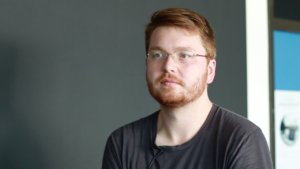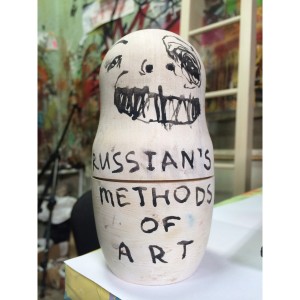I usually focus on productivity. How can I optimize the processes to stay active? I am trying to figure out what conditions I need in order to work and then I try to establish them. I was given money for sitting there and completing a simple task. I tore out pages from stacks of newspapers and marked the title of the newspaper and the advert. You have to imagine: the newspaper here, me in the middle, and the garbage can over there. The motion was as follows: newspaper down, opening it, tearing it out and throwing it into the bin. From the stack to the dustbin with myself in between: very monotonous. At first, I thought it was great. I had a lot of time to think. I discovered photos, every once in a while. I thought maybe I would use it as an inspiration for a drawing or use it in a letter. I started to notice that my collection was growing. I went to my professor and he said: ‚Don’t put too much energy in this. Feldmann has done that already.‘ Nevertheless, I went on because I found more interesting things. I found it interesting that it had passed through so many hands, and was actually trash already. I still find it interesting to show something that was already there. Anyone could have seen it, but it is you who spotted it. That’s fun. I spy with my little eye…‘ That’s something I learned back in 1997 or so. ‚land for future development‘, you found it in the gazette, went to the computer lab of the HfbK, scanned it -an image on scanner, let the scan process, had a coffee, and after 15 minutes went back to the lab. The image was scanned. After that, you cut it out which meant using the cutting device, which took three minutes until it was cut, another five minutes until it was cut out, two minutes for saving the 2MB. It took 20 minutes in total for it to be processed on my data storage device. Twenty minutes. Today we can only laugh about that amount of time, because now it takes thirty seconds. But during these twenty minutes I was thinking about what I was doing, the entire time. It is my job; you could almost say it is my duty. When I did my big newspaper book, I scanned 1500 images myself. I could have asked someone else to do it but I wanted to do it myself. I wanted to scan a month or two and think about what I was doing and what should be in the book. This was all part of it. For me, many things have come from everyday life… actually. I started collecting photographs from newspapers because I was sitting 20 hours a week in an agency and thought to myself: ‚for heaven’s sake, so much of my lifetime is passing. I am an artist and not a worker in an office…‘ Another example is: I have started taking pictures of things while driving to Leipzig. I spend a lot of time in Leipzig. I always thought that driving a car is great: monotonous and I can concentrate well. I am alone – actually, a good working environment – then I started taking pictures from the car because something caught my attention. I went on doing this for a while. Or my son took pictures of me sleeping. And I made a project with these photos. It was just there. It just caught my attention. I experienced that quite often I had been around pictures for a long time before I realized something. I asked myself: ‚Why did you see this just now? You could have seen it earlier. ‚You don’t have to suffer a lot but rather, stay ready for input. I think that’s what it’s all about. There is a studio, but it doesn’t look like a typical studio. It is small. Basically, I don’t need a studio, maybe just to hang things on the wall and look at them. For work, I do not necessarily need a studio.
Ich gucke immer danach ‚Was ist produktiv?’ Wie kann ich die Abläufe optimieren, damit ich tätig bin? Ich versuche herauszubekommen, was Bedingungen sind, damit ich etwas herstellen kann. Dann versuche ich das zu bauen. Bei mir sind tatsächlich viele Sachen aus dem Alltag gekommen. Ich habe angefangen, Zeitungsbilder zu sammeln weil ich in einer Agentur als Lohnarbeiter saß, wo ich ohnehin zwanzig Stunden in der Woche sitzen musste ich dachte ‚Um Himmels Willen soviel Lebenszeit und ich bin doch eigentlich Künstler und nicht im Büro…’. Also das war so: Ich saß da und habe Geld dafür bekommen, dass ich da saß und eine ganz einfache Arbeit gemacht habe, nämlich aus Stapeln von Zeitungen Seite drei rauszureißen und drauf zuschreiben‚ das war die Zeitung, Seite 3, da ist die Anzeige. Sie müssen sich das so vorstellen, hier war die Zeitung, hier war mein Platz und da war die Mülltonne und die Bewegung war folgende: Zeitung runter, aufschlagen, abreißen und ab in die Mülltonne. Es war wirklich so ein vom Stapel in die Mülltonne und ich war dazwischen. Ganz, ganz monoton. Anfangs fand ich das toll, denn ich hatte die Freiheit, über alles Mögliche nachzudenken, ich musste ja nicht über diese Arbeit nachdenken. Dann fielen mir halt Photos auf und ich habe ab und zu eins aufgehoben, weil ich dachte, vielleicht zeichne ich mal danach oder klebe es unter einen Brief, den ich schreibe. Zunehmend habe ich gemerkt, es wird immer mehr, dann habe ich es meinem Professor gezeigt, der sagte ‚Intensivier das bloß nicht, das hat doch der Feldmann alles schon gemacht. Da ist nichts mehr rauszuholen.` Trotzdem habe ich weitergemacht, weil immer wieder neue interessante Sachen hinzukamen und weil ich es interessant fand, dass es durch so viele Hände geht, eigentlich schon im Müll war. Noch heute finde ich es interessant, wenn man etwas zeigen kann, was schon da ist und alle hätten sehen können und man selber sieht es aber. Das macht mir einfach Spaß. Ich sehe was, was du nicht siehst. Es ist auch etwas, was ich damals gelernt habe 1997 oder so: Bauerwartungsfläche gefunden im Dingolfinger Anzeiger, dann ins Computerlabor der HfbK, dann an den Scanner, Bild aufgelegt, Scanvorgang gestartet, Kaffee getrunken, nach einer viertel Stunde wiedergekommen, Bild fertig. Dann Ausschneidewerkzeug angelegt, drei Minuten bis es ausgeschnitten war, noch mal fünf Minuten bis es gedreht war, zwei Minuten für das Sichern von den 2MB. Das waren insgesamt zwanzig Minuten bis es sozusagen verarbeitet, fertig auf meinem Speichermedium lag. Zwanzig Minuten. Da lacht man heute drüber, weil es mittlerweile in dreißig Sekunden geht. Aber während dieser zwanzig Minuten habe ich darüber nachgedacht, was ich tat. Und zwar die ganze Zeit. Das ist meine Aufgabe, man könnte fast sagen meine Pflicht. Oder als dieses große Zeitungsbuch gemacht habe, da sind 1.500 Zeitungsbilder drin, die habe ich alle selber gescannt, nicht weil ich das nicht hätte abgeben können, sondern weil ich das wollte. Ich wollte einen oder zwei Monate scannen und noch mal darüber nachdenken, was ich da eigentlich tue und was in das Buch rein soll. Das gehörte alles dazu. Oder ich habe jetzt angefangen, Dinge aus dem Auto zu photographieren, weil ich die ganze Zeit nach Leipzig fahre und viel Zeit im Auto verbringe. Und ich dachte immer, Auto fahren ist super, so schön monoton, ich kann mich gut konzentrieren, bin allein – eigentlich ein gutes Arbeitsklima – dann habe ich angefangen aus dem Auto zu photographieren, weil mir etwas aufgefallen war. Das habe ich eine Zeit lang immer wieder getan. Oder mein Sohn hat Photos von mir gemacht während ich schlief und dann habe ich ein Projekt mit diesen Photos gemacht. Es war einfach da. Die meisten Dinge fallen mir auf. Das ist auch die Erfahrung, die ich gemacht habe, das ich ganz oft mit interessanten Bildern schon lange in Kontakt war bis ich darauf aufmerksam wurde und mich im Nachhinein häufig gefragt habe: Warum bist du denn erst jetzt draufgekommen? Das hättest du doch schon am Anfang sehen können. Man muss nicht wahnsinnige Anstrengungen unternehmen, sondern man muss sich eher bereit machen für die Aufnahme einer Wahrnehmung. Ich glaube es geht eher darum. Es gibt ein Atelier, aber das sieht nicht aus wie ein Atelier. Es ist klein. Ich brauche im Grunde kein Atelier, vielleicht nur um Sachen aufzuhängen und mir an der Wand anzugucken. Aber zum Arbeiten brauche ich nicht unbedingt ein Atelier.

















